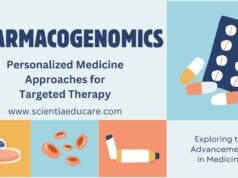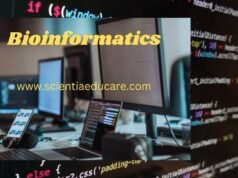Bioinformatics: Essential Tools and Real-World Applications in Life Sciences
Introduction
Bioinformatics is an interdisciplinary field that combines biology, computer science, and mathematics to analyze and interpret biological data. It plays a crucial role in genomics, proteomics, drug discovery, and systems biology. With the exponential growth of biological data, bioinformatics tools have become indispensable in modern life sciences research.
Best bioinformatics software tools,
Applications of bioinformatics in medicine,
Molecular modeling for drug discovery,
Low-cost bioinformatics tools online,
Bioinformatics databases for beginners.
What is Bioinformatics?
Bioinformatics involves the development and application of computational techniques to understand biological processes. It helps in organizing and analyzing complex biological data such as DNA sequences, protein structures, and metabolic pathways.
Key Areas of Bioinformatics
- Genomics – Study of entire genomes of organisms
- Proteomics – Analysis of protein structures and functions
- Transcriptomics – Study of RNA sequences and their expressions
- Metabolomics – Study of metabolic pathways and small molecules
- Structural Biology – Analysis of biomolecular structures
Essential Bioinformatics Tools
1. Sequence Alignment Tools
These tools compare DNA, RNA, or protein sequences to identify similarities and evolutionary relationships.
- BLAST (Basic Local Alignment Search Tool) – Used for searching sequence databases (https://blast.ncbi.nlm.nih.gov/Blast.cgi)
- Clustal Omega – Multiple sequence alignment tool (https://www.ebi.ac.uk/Tools/msa/clustalo/)
- MAFFT – A fast and accurate sequence alignment tool (https://mafft.cbrc.jp/alignment/software/)
2. Genome Analysis Tools
- NCBI GenBank – A database for publicly available DNA sequences (https://www.ncbi.nlm.nih.gov/genbank/)
- ENSEMBL – Genome browser for vertebrates and model organisms (https://www.ensembl.org/)
- UCSC Genome Browser – Provides a graphical interface to visualize genomic data (https://genome.ucsc.edu/)
3. Protein Structure Prediction and Analysis Tools
- Swiss-Prot/UniProt – A protein sequence database (https://www.uniprot.org/)
- PDB (Protein Data Bank) – A database for 3D protein structures (https://www.rcsb.org/)
- AlphaFold – AI-based protein structure prediction tool (https://www.alphafold.ebi.ac.uk/)
4. Phylogenetic Analysis Tools
- MEGA (Molecular Evolutionary Genetics Analysis) – Constructs phylogenetic trees (https://www.megasoftware.net/)
- PhyML – A maximum likelihood phylogenetics tool (http://www.atgc-montpellier.fr/phyml/)
5. Molecular Docking and Drug Discovery Tools
- AutoDock – Molecular docking tool used in drug design (https://autodock.scripps.edu/)
- SwissDock – Web-based docking tool (http://www.swissdock.ch/)
- DockThor – Online molecular docking platform (https://www.dockthor.lncc.br/)
6. Metabolic Pathway Analysis Tools
- KEGG (Kyoto Encyclopedia of Genes and Genomes) – Pathway database (https://www.genome.jp/kegg/)
- BioCyc – Database of metabolic pathways (https://biocyc.org/)
Applications of Bioinformatics in Life Sciences
1. Genomic Data Analysis
- Genome sequencing and annotation
- Identification of disease-causing mutations
- Personalized medicine and precision healthcare
2. Drug Discovery and Development
- Virtual screening of potential drug candidates
- Predicting drug interactions and side effects
- Target identification and molecular docking simulations
3. Agriculture and Crop Improvement
- Identification of genes for disease resistance in crops
- Enhancing yield and stress tolerance in plants
- Genetic modification for improved agricultural traits
4. Evolutionary and Phylogenetic Studies
- Understanding the evolutionary relationships between species
- Studying genetic diversity and population genetics
5. Systems Biology and Network Analysis
- Modeling biological networks and pathways
- Analyzing gene regulatory networks
- Identifying biomarkers for diseases
Challenges in Bioinformatics
- Data Storage and Management – Handling massive biological datasets
- Computational Complexity – Processing high-throughput sequencing data
- Data Accuracy and Quality Control – Ensuring reliable and reproducible results
- Interdisciplinary Expertise – Bridging the gap between biology and computer science
Future Trends in Bioinformatics
- Artificial Intelligence (AI) in Bioinformatics – AI-driven protein structure prediction and drug discovery
- Big Data Analytics – Managing and interpreting large-scale genomic data
- Cloud Computing in Bioinformatics – Enhancing data accessibility and computational efficiency
- CRISPR and Gene Editing – Revolutionizing genetic research and therapies
Further Reading
- National Center for Biotechnology Information (NCBI) – https://www.ncbi.nlm.nih.gov/
- European Bioinformatics Institute (EMBL-EBI) – https://www.ebi.ac.uk/
- The Human Genome Project – https://www.genome.gov/
- Bioinformatics Resource Portal – https://www.expasy.org/
Conclusion
Bioinformatics is an evolving discipline that has transformed life sciences research. With the rapid advancements in computational techniques, bioinformatics continues to play a critical role in genomics, drug discovery, and systems biology. By leveraging various bioinformatics tools, researchers can gain deeper insights into biological processes and accelerate scientific discoveries.
MCQs with answers and explanations on “Bioinformatics: Tools and Applications in Life Sciences.”
1. What is the primary objective of bioinformatics?
A) Storing and retrieving biological data
B) Analyzing biological sequences
C) Developing algorithms for biological problems
D) All of the above
✅ Answer: D) All of the above
Explanation: Bioinformatics involves storing, retrieving, analyzing biological data, and developing computational tools to interpret complex biological information.
2. Which of the following is a widely used biological database?
A) GenBank
B) MATLAB
C) AutoCAD
D) MS Excel
✅ Answer: A) GenBank
Explanation: GenBank is a public database of nucleotide sequences maintained by NCBI.
3. BLAST is used for:
A) DNA sequencing
B) Protein purification
C) Sequence alignment
D) Gene cloning
✅ Answer: C) Sequence alignment
Explanation: BLAST (Basic Local Alignment Search Tool) compares nucleotide or protein sequences to database sequences for alignment and similarity searches.
4. What does FASTA format represent?
A) A compression algorithm
B) A sequence alignment tool
C) A text-based format for storing nucleotide/protein sequences
D) A database for protein structures
✅ Answer: C) A text-based format for storing nucleotide/protein sequences
Explanation: FASTA format is widely used in bioinformatics for storing and analyzing biological sequences.
5. What is the full form of NCBI?
A) National Centre for Biological Information
B) National Center for Biotechnology Information
C) Network of Computational Bioinformatics Institutes
D) National Computational Biology Institute
✅ Answer: B) National Center for Biotechnology Information
Explanation: NCBI is a key resource for biological databases, including GenBank and BLAST.
6. What is the primary goal of structural bioinformatics?
A) Protein sequence alignment
B) DNA sequencing
C) Prediction and analysis of 3D structures of biomolecules
D) Gene editing
✅ Answer: C) Prediction and analysis of 3D structures of biomolecules
Explanation: Structural bioinformatics focuses on predicting and analyzing molecular structures to understand function and interactions.
7. Which of the following tools is used for phylogenetic analysis?
A) MEGA
B) PyMOL
C) SPSS
D) AutoDock
✅ Answer: A) MEGA
Explanation: MEGA (Molecular Evolutionary Genetics Analysis) is widely used for phylogenetic tree construction and evolutionary studies.
8. What is multiple sequence alignment (MSA)?
A) A technique for DNA sequencing
B) An approach for aligning more than two sequences
C) A method for visualizing gene structures
D) A type of protein purification
✅ Answer: B) An approach for aligning more than two sequences
Explanation: MSA is used to align multiple biological sequences to find conserved regions and evolutionary relationships.
9. Which of the following is a widely used tool for multiple sequence alignment?
A) BLAST
B) Clustal Omega
C) AutoDock
D) Chimera
✅ Answer: B) Clustal Omega
Explanation: Clustal Omega is an efficient tool for performing multiple sequence alignments of proteins and nucleotides.
10. What is the function of RASMOL?
A) Gene prediction
B) Molecular visualization
C) Sequence alignment
D) Phylogenetic tree construction
✅ Answer: B) Molecular visualization
Explanation: RasMol is a software tool used to visualize 3D molecular structures of proteins and nucleic acids.
11. Which type of database is UniProt?
A) Protein sequence database
B) Nucleotide sequence database
C) 3D protein structure database
D) Metabolic pathway database
✅ Answer: A) Protein sequence database
Explanation: UniProt (Universal Protein Resource) is a comprehensive database of protein sequences and annotations.
12. Which of the following is NOT a genome database?
A) Ensembl
B) KEGG
C) UCSC Genome Browser
D) SWISS-PROT
✅ Answer: D) SWISS-PROT
Explanation: SWISS-PROT is a protein sequence database, while the others focus on genome information.
13. The abbreviation KEGG stands for:
A) Kyoto Encyclopedia of Genes and Genomes
B) Knowledge Extraction of Genetic Genomes
C) Korean Environmental Gene Group
D) Key Experimental Genome Guide
✅ Answer: A) Kyoto Encyclopedia of Genes and Genomes
Explanation: KEGG is a database that integrates genomic, chemical, and systemic functional information.
14. Which programming language is widely used in bioinformatics?
A) JavaScript
B) Python
C) PHP
D) Swift
✅ Answer: B) Python
Explanation: Python is commonly used due to its libraries like Biopython for biological data analysis.
15. Which software is used for protein-ligand docking studies?
A) AutoDock
B) Clustal Omega
C) BLAST
D) RasMol
✅ Answer: A) AutoDock
Explanation: AutoDock is used for molecular docking simulations in drug discovery.
16. What is the purpose of the PDB (Protein Data Bank)?
A) Stores genomic sequences
B) Provides protein 3D structural data
C) Houses biochemical reaction data
D) Contains nucleotide sequences
✅ Answer: B) Provides protein 3D structural data
Explanation: PDB contains structural data of proteins obtained via X-ray crystallography and NMR.
17. What is Next-Generation Sequencing (NGS)?
A) A technique for DNA amplification
B) A high-throughput method for sequencing DNA/RNA
C) A method of bacterial transformation
D) A technique for visualizing proteins
✅ Answer: B) A high-throughput method for sequencing DNA/RNA
Explanation: NGS allows rapid sequencing of whole genomes or transcriptomes.
18. What is a transcriptome?
A) A DNA sequencing tool
B) The complete set of RNA transcripts in a cell
C) A method of DNA amplification
D) A protein structure database
✅ Answer: B) The complete set of RNA transcripts in a cell
Explanation: The transcriptome includes all RNA molecules, helping study gene expression.
19. Which tool is used for RNA secondary structure prediction?
A) RNAfold
B) BLAST
C) ClustalW
D) MEGA
✅ Answer: A) RNAfold
Explanation: RNAfold predicts secondary structures of RNA molecules using thermodynamic calculations.
20. Which of the following is NOT a bioinformatics application?
A) Gene prediction
B) Drug discovery
C) Rocket propulsion
D) Phylogenetic analysis
✅ Answer: C) Rocket propulsion
Explanation: Bioinformatics is used in biological research, not in aerospace technology.














